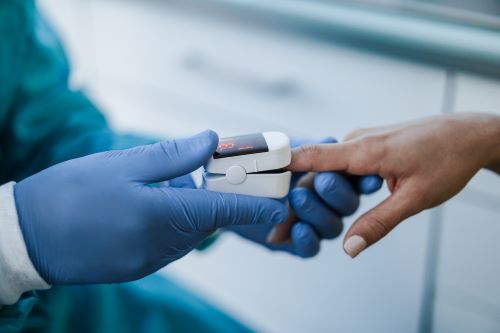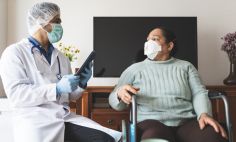Pulse oximeters have been used in hospitals and doctors’ offices for decades. The small, painless devices measure blood oxygen saturation, which helps doctors decide how to treat patients. During the COVID-19 pandemic, which is in part a respiratory illness, over-the-counter oximeters became more popular for home-based use and were in increasing demand.
People using over-the-counter pulse oximeters should know the limitations of these devices and how to read them. It is also important to note that the accuracy of pulse oximeters can be affected by a variety of factors—including skin pigmentation.
How do pulse oximeters work?
Pulse oximeters clip onto a fingertip and send beams of red and infrared light through tissues such as the nail, skin, and blood. The amount of oxygen in the tissue—called oxygen saturation—affects how well it absorbs light. The clip’s sensor measures how much light passes through without first getting absorbed by the tissue.
Oxygen saturation levels could be a sign of how someone’s lungs are working. If blood oxygen levels are below normal (a condition called hypoxemia), patients could have headaches, dizziness, or shortness of breath. Hypoxemia can also lead to hypoxia, which occurs when the body lacks oxygen at the tissue level. This can cause headaches, trouble breathing, confusion, and bluish coloring in the skin, fingernails, or lips.
Who uses pulse oximeters?
The U.S. Food and Drug Administration (FDA) currently states that there are two categories of pulse oximeters: those for prescription use and those that can be purchased over the counter.
- Prescription oximeters have been vetted by the FDA and are available only with a prescription. These devices have undergone clinical testing to confirm their accuracy and are typically used in clinical settings, although they can be prescribed for at-home use.
- Over-the-counter oximeters are sold directly to consumers and may use apps to estimate oxygen saturation. These products do not undergo FDA review and should not be used for medical purposes.
Doctors, nurses, and paramedics use prescription pulse oximeter readings as one factor to help decide how to best care for patients. Anesthesiologists use them to help determine how much anesthesia to give patients and to monitor their respiratory status. Medical providers may use a pulse oximeter or may prescribe one for home use for patients with any of these conditions:
- Asthma
- Lung cancer
- Chronic obstructive pulmonary disease (COPD)
- Influenza
- COVID-19
- Sleep apnea
- Carbon monoxide poisoning or injury from smoke inhalation
- Pneumonia
- Cystic fibrosis
- Heart disease
- A need for pain medications, including opioids, which could limit the ability to breathe
More people are buying non-FDA-cleared, over-the-counter oximeters intended for fitness and general wellness to track their oxygen saturation at home. However, these versions of the device are not approved or cleared for medical purposes or decisions.
How can you read a pulse oximeter?
Read the manufacturer’s instructions before using a pulse oximeter at home. The intended use of your pulse oximeter should be available in the manufacturer’s instructions. Make sure your hand is warm and relaxed and is resting below your heart. Remove any fingernail polish or artificial nails on the finger being tested. Keep your body still. When the numbers on your device are steady and stop changing, record the levels, date, and time of the reading. Track how they change and tell your doctor if they do.
Pulse oximeters are most accurate when blood oxygen saturation is between 90% and 100%. Accuracy decreases when blood oxygen saturation is between 80% and 90%, and the devices are least accurate when saturation is below 80%. Keep in mind that readings may be off by a few percentage points. For example, if an FDA-cleared pulse oximeter reads 90%, then the actual oxygen saturation in the blood is generally between 86% and 94%.
Most healthy people have blood oxygen levels between 95% and 100%, but this can be lower for people with lung problems.
Remember: The FDA only reviews the accuracy of prescription pulse oximeters, not over-the-counter oximeters meant for general wellness or fitness purposes. If you think your prescription pulse oximeter is not working, you can report problems with the device by using the FDA’s MedWatch online voluntary reporting form.
What other symptoms of low oxygen levels should you look for?
FDA recommends that people who use pulse oximeters at home pay attention to other signs or symptoms of low oxygen levels and whether those symptoms change over time. These may include:
- Bluish coloring in the face, lips, or nails
- Shortness of breath, difficulty breathing, or a cough that gets worse
- Restlessness and discomfort
- Chest pain or tightness
- Fast or racing heart rate
Some patients with low oxygen levels may not show any of these symptoms. Only a health care provider can diagnose a medical condition such as hypoxia. Because several factors can affect the accuracy of readings, the FDA recommends medical providers make treatment decisions based on pulse oximeter readings over time. The FDA also recommends checking the accuracy information on the device manufacturer’s website.
What factors can affect pulse oximeter readings?
Any of these factors can affect pulse oximeter readings:
- Fingernail polish or artificial nails
- Skin temperature: A skin temperature of about 91.4°F is recommended
- Altitude
- Intravenous dyes: These are used to color blood serum for surgical or diagnostic purposes and can affect light absorption
- Poor circulation
- Skin thickness
- Tobacco use
- Skin pigmentation
Are pulse oximeters less accurate for people of color?
Recent studies have suggested that prescription pulse oximeters may be less accurate for people with darker skin tones. Melanin (the natural pigment that gives skin, eyes, and hair their color) absorbs the red and infrared light from pulse oximeters, and the amount of melanin you have can change how much light is absorbed. People with darker skin tones have more melanin, and this could potentially lead some of the devices to give falsely high readings and medical providers to give these patients less supplemental oxygen in health care settings.
Qi Duan, Ph.D., a Program Director for the National Institute of Biomedical Imaging and Bioengineering’s (NIBIB) Division of Health Informatics Technologies, said the increased use of pulse oximeters during the pandemic accelerated the publication of research around disparities in readings for patients of color. These NIH-funded studies during the pandemic looked at pulse oximeter accuracy for dark-skinned patients in hospital settings:
Case study #1: Assessment of Racial and Ethnic Differences in Oxygen Supplementation Among Patients in the Intensive Care Unit
One study funded by NIBIB and the National Institute of Diabetes and Digestive and Kidney Diseases looked at 3,069 Black, White, Hispanic, and Asian patients treated in the intensive care unit at Beth Israel Deaconess Medical Center in Boston, Massachusetts. The study compared 11 years of readings from pulse oximeters to actual blood oxygenation levels from arterial blood gas tests, which are considered more reliable. Researchers found that pulse oximeter readings were artificially higher than actual blood oxygenation levels in non-White patients.
Case study #2: Racial Bias in Pulse Oximetry Measurement
Another study at the University of Michigan, supported by the National Library of Medicine and the National Heart, Lung, and Blood Institute, examined pulse oximeter readings from White and Black patients between 2014 and 2015 and in 2020. This study found that Black patients were nearly three times more likely to have occult (hidden from view) hypoxemia than White patients. Researchers said relying on the devices to triage patients could place Black patients at increased risk of hypoxemia.
What is being done about addressing disparities in pulse oximeters?
Researchers need more evidence to determine whether the racial disparities found in these case studies were specific to those hospitals or if this is a widespread problem. Better data science and collection of information from medical devices can help track patterns that lead to health disparities.
“With the advancement in data mining tools and capabilities, trends in pulse oximeter accuracy can be [revealed] and analyzed, and recent evidence suggested that there might be a potential racial disparity in pulse oximeter accuracy,” Dr. Duan said.
Health care providers can develop unconscious biases if they base treatment decisions on data that do not account for a wide range of backgrounds or conditions. Pulse oximeters are considered reliable technology, but manufacturers should test them on a diverse group of subjects. The FDA requires that medical-grade devices be tested on subjects with “darkly pigmented” skin, and the tests require at least two subjects or 15% of the trial group—whichever is more—be people of color.
The agency is considering new guidance around testing for skin tone disparities. On November 1, 2022, the FDA heard from a committee of medical experts, device manufacturers, and patient advocates about ongoing concerns that pulse oximeters may be less accurate in individuals with darker skin. The FDA will review the committee’s recommendations and consider additional testing or labeling requirements for over-the-counter devices.
In addition to testing being more diverse, Dr. Duan said finding solutions to these problems needs to be inclusive as well.
“It may take a multipronged approach to address this apparent issue,” Dr. Duan said. He noted that research studies need to better understand this problem and its causes, technological innovations to increase pulse oximeter accuracy and robustness, and outreach to health care professionals and caregivers to spread awareness about the studies’ observations.
Know the difference between pulse oximeters
Pulse oximeters may be prescribed by a doctor or purchased over the counter. The FDA recommends knowing the difference so that patients use pulse oximeters safely. Prescription oximeters are reviewed by the FDA; available by prescription only; have undergone clinical testing; and are used for medical purposes. Over-the-counter oximeters are available without a prescription (i.e. purchased in stores, online, or via mobile app); and used for general wellness or fitness activities. Both types of oximeters can be used at home.
An alternative to pulse oximeters
An arterial blood gas test is more invasive and painful than using a pulse oximeter, but it’s a more accurate way to measure oxygen and carbon dioxide in your blood as well as the balance of acids and bases. Having too much or too little acid in your blood can be harmful.
More NIH efforts to improve health disparities
New pulse oximeter design wins NIBIB 2022 DEBUT Challenge
A team from Johns Hopkins University in Baltimore, Maryland, won first place in the 2022 Design by Biomedical Undergraduate Teams (DEBUT) Challenge for their EquinOx pulse oximeter. The EquinOx is better able to estimate blood oxygen saturation levels using its new hardware that measures both skin tone and the device’s raw data. The $20,000 prize includes coaching to make the device commercially available. Read more about the DEBUT Challenge.
Technology Development to Reduce Health Disparities
This research project grant from NIBIB and the National Institute on Minority Health and Health Disparities (NIMHD) supports medical technologies aimed at reducing disparities in health care access and health outcomes. NIBIB and NIMHD seek technologies that are effective, affordable, culturally acceptable, and deliverable. Learn more about this funding opportunity.
NIH Minority Health and Health Disparities Strategic Plan 2021–2025
This five-year plan sets goals for NIH to address health disparities among racial and ethnic minority groups in medical research and clinical care. These goals include testing common health indicators to measure the scale of health disparities across different diseases, conditions, and populations. Another goal is to include more minorities and members of health disparity populations in big data sets, clinical research, and future big science initiatives. Read more about the Strategic Plan.







